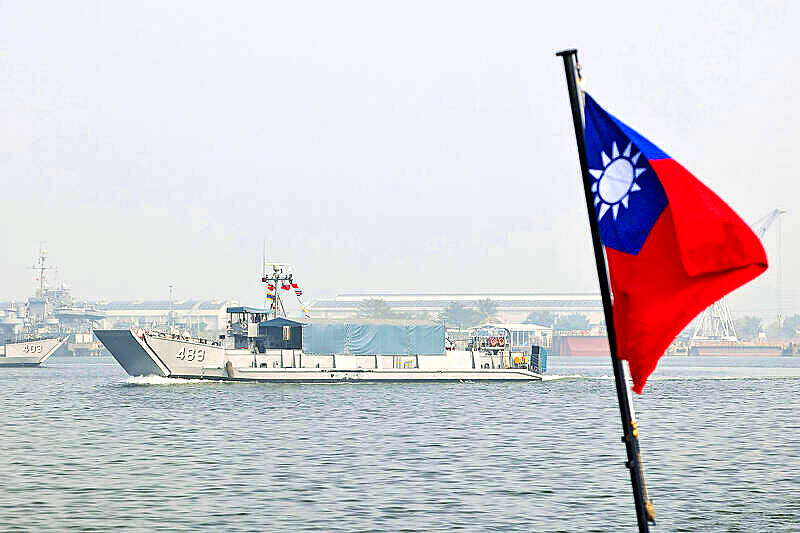Taiwan and the US have signed a two-year specialized training program for the local navy, the Ministry of National Defense said yesterday, in an unexpected announcement confirming US training.
The US has a history of stationing military instructors and special operations teams in Taiwan to quietly assist with training, but details have been classified.
On Jan. 2, the ministry’s military delegation to the US signed an agreement with the American Institute in Taiwan, an announcement from the ministry showed.

Photo: Ann Wang, Reuters
The agreement states that the US government would send personnel to Taiwan to conduct a two-year specialized naval training program with a budget of NT$49,887,240 (US$1,515,132).
The training program would take place at Kaohsiung’s Zuoying (左營), the headquarters of the navy and marine corps.
The program is likely related to amphibious combat training with the amphibious naval fleet and marine corps.
Although the budget is not high, it is the first time a “specialized training program” with the US has been officially announced, a military source said on condition of anonymity.
The US has changed its low-key and confidential training approach to a semi-public approach, testing political and public reactions, the source said.
The two nations had previously implemented a training regime in which the US military instructed Taiwan’s amphibious naval fleet and marine corps on joint operations.
However, the project was interrupted when official relations between the US and Taiwan were severed, until 2017 when small-scale exchanges resumed.
In recent years, the marine corps has been sending troops to the US and Guam to receive military training, military reports said.
Washington has also sent senior instructors and small units to Taiwan to provide combat training assistance, but no public confirmations have been made until now.

TRAGEDY STRIKES TAIPEI: The suspect died after falling off a building after he threw smoke grenades into Taipei Main Station and went on a killing spree in Zhongshan A 27-year-old suspect allegedly threw smoke grenades in Taipei Main Station and then proceeded to Zhongshan MRT Station in a random killing spree that resulted in the death of the suspect and two other civilians, and seven injured, including one in critical condition, as of press time last night. The suspect, identified as a man surnamed Chang Wen (張文), allegedly began the attack at Taipei Main Station, the Taipei Fire Department said, adding that it received a report at 5:24pm that smoke grenades had been thrown in the station. One man in his 50s was rushed to hospital after a cardiac arrest

SAFETY FIRST: Double the number of police were deployed at the Taipei Marathon, while other cities released plans to bolster public event safety Authorities across Taiwan have stepped up security measures ahead of Christmas and New Year events, following a knife and smoke bomb attack in Taipei on Friday that left four people dead and 11 injured. In a bid to prevent potential copycat incidents, police deployments have been expanded for large gatherings, transport hubs, and other crowded public spaces, according to official statements from police and city authorities. Taipei Mayor Chiang Wan-an (蔣萬安) said the city has “comprehensively raised security readiness” in crowded areas, increased police deployments with armed officers, and intensified patrols during weekends and nighttime hours. For large-scale events, security checkpoints and explosives

A car bomb killed a senior Russian general in southern Moscow yesterday morning, the latest high-profile army figure to be blown up in a blast that came just hours after Russian and Ukrainian delegates held separate talks in Miami on a plan to end the war. Kyiv has not commented on the incident, but Russian investigators said they were probing whether the blast was “linked” to “Ukrainian special forces.” The attack was similar to other assassinations of generals and pro-war figures that have either been claimed, or are widely believed to have been orchestrated, by Ukraine. Russian Lieutenant General Fanil Sarvarov, 56, head

PUBLIC SAFETY: The premier said that security would be tightened in transport hubs, while President Lai commended the public for their bravery The government is to deploy more police, including rapid response units, in crowded public areas to ensure a swift response to any threats, President William Lai (賴清德) said yesterday after a knife attack killed three people and injured 11 in Taipei the previous day. Lai made the remarks following a briefing by the National Police Agency on the progress of the investigation, saying that the attack underscored the importance of cooperation in public security between the central and local governments. The attack unfolded in the early evening on Friday around Taipei Main Station’s M7 exit and later near the Taipei MRT’s Zhongshan